Science & Technology


MOSCOW: Russia has decided to quit the International Space Station “after 2024”, the newly appointed chief of Moscow’s space agency told President Vladimir Putin on Tuesday.
The announcement comes as tensions rage between the Kremlin and the West over Moscow’s military intervention in Ukraine and several rounds of unprecedented sanctions against Russia. Russia and the United States have worked side by side on the ISS, which has been in orbit since 1998.
“Of course, we will fulfil all our obligations to our partners, but the decision to leave this station after 2024 has been made,” Yury Borisov, who was appointed Roscosmos chief in mid-July, told Putin.
“I think that by this time we will start putting together a Russian orbital station,” Borisov added, calling it the space programme’s main “priority”.
“Good,” Putin replied in comments released by the Kremlin.
Until now space exploration was one of the few areas where cooperation between Russia and the United States and its allies had not been wrecked by tensions over Ukraine and elsewhere. Borisov said the space industry was in a “difficult situation”.
He said he would seek “to raise the bar, and first of all, to provide the Russian economy with the necessary space services”, pointing to navigation, communication, and data transmission, among other things.
Sending the first man into space in 1961 and launching the first satellite four years earlier are among key accomplishments of the Soviet space programme and remain a major source of national pride in Russia.
But experts say the Russian space agency remains a shadow of its former self and has in recent years suffered a series of setbacks including corruption scandals and the loss of a number of satellites and other spacecraft.
Borisov, a former deputy prime minister with a military background, has replaced Dmitry Rogozin, a firebrand nationalist politician known for his bombastic statements and eccentric behaviour.
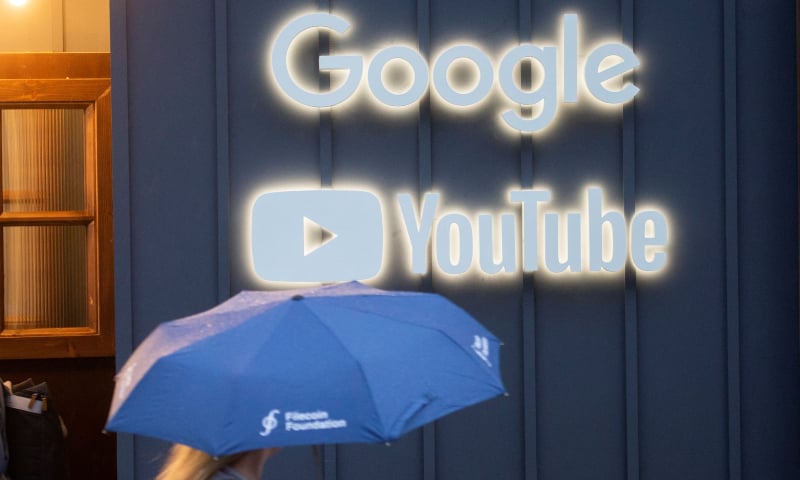
BRUSSELS: Google parent Alphabet has offered to let rival ad intermediaries place ads on YouTube to address a crucial part of an EU anti-trust investigation that could pave the way for it to settle the case without a fine, people familiar with the matter said.
The European Commission opened a probe last year to examine whether the world’s largest provider of search and video was giving itself an unfair advantage in digital advertising by restricting rivals’ and advertisers’ access to user data.
The EU competition watchdog singled out Google’s requirement that advertisers use its Ad Manager to display ads on YouTube and potential restrictions on the way in which rivals serve ads on YouTube.
It is also looking into Google’s requirement that advertisers use its services Display & Video 360 and Google Ads to buy YouTube ads. YouTube posted $6.9 billion in sales in the first quarter of this year. Google has been discussing remedies with the commission since last year in a bid to avert a fine that could reach 10 per cent of its global turnover, a person familiar with the matter said last year.
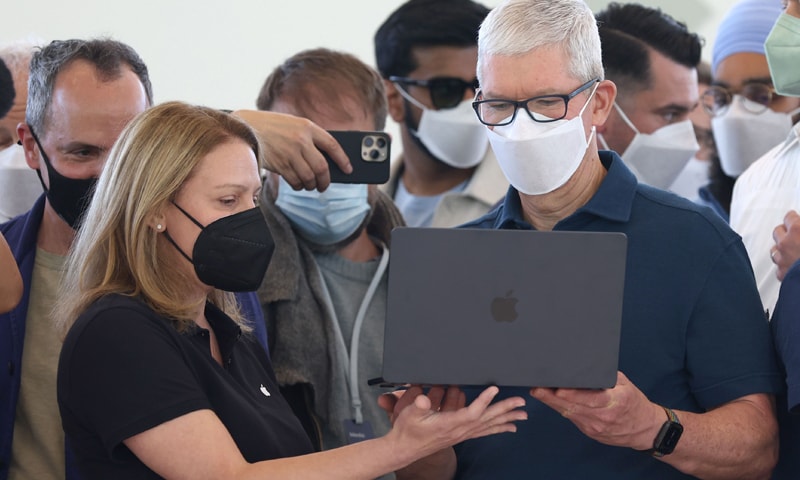
Apple CEO Tim Cook (R) looks at a newly redesigned MacBook Air laptop during the WWDC22 at Apple Park on June 06, 2022 in Cupertino, California. — AFP CUPERTINO: Apple Inc on Monday announced it would more deeply integrate its software into cars, while the iPhone maker rolled out a slew of features for collaboration and safety.
Apple also announced that its new MacBook Air laptop was redesigned around its new M2 silicon processor, which it says is 35pc faster than the previous M1 chip. The new laptop will be 2.7 pounds (1.2 kg) and have a 1080p high-definition camera to provide better images on video calls. The MacBook Air will start at $1,199, Apple announced at its annual software developer conference.
The M2 chip will also power the 13-inch MacBook Pro, which will start at $1,299 and be available next month. Prices are $100 lower for education customers as Apple targets the back-to-school market.
Apple showed off a new car dashboard that it said would be able to display major instruments such as speed and gas mileage. Apple said automakers such as Ford Motor Co, Nissan Motor Co and Honda Motor Corp are planning to use the new CarPlay software in upcoming models.
Apple also announced that users can buy now and pay later for purchases. Apple Pay Later will be available anywhere that Apple Pay is accepted and managed through the Apple Wallet. Users can make four equal payments with no interest or fees. Apple also added an edit button to iMessage for sent messages, beating Twitter to a long-requested feature.
The tech giant is also adding a tool called “Safety Check” to turn off access to sensitive information for people in abusive situations. Apple introduced a new technology called Passkeys to replace passwords on websites. Apple said Passkeys are safer than traditional passwords because Passkeys are never stored on a web server. The company said it is working to enable the use of Passkeys with non-Apple devices.
Apple also introduced tweaks to popular apps including live sport scores on Apple TV, making the shared video-watching app available in messaging and shared tabs on its browser.
More than an hour into the presentation, Apple shares were up less than 1pc, similar to their level at the start.
Apple did not provide any hints about future devices such as a mixed-reality headset. Such a device would be Apple’s first entry into a new category of computing device since the Apple Watch shipped in 2015 and would put it in direct competition with Meta, which has disclosed plans for a mixed-reality headset code named “Cambria” to be released this year.
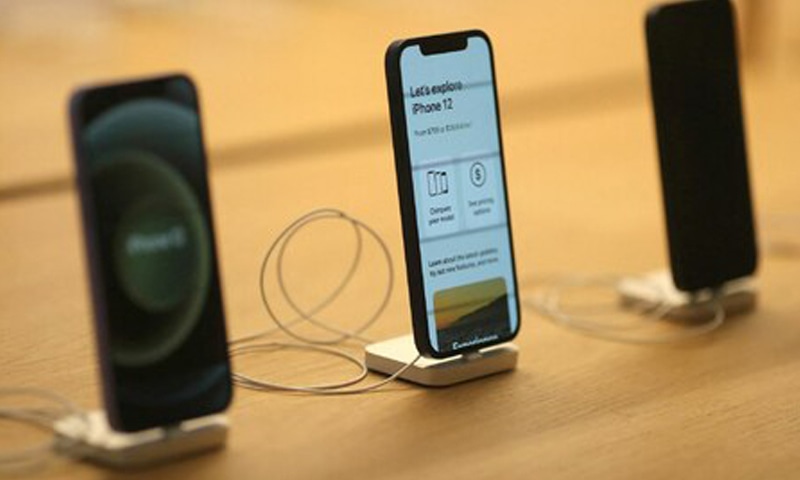
BRUSSELS: EU countries and lawmakers are set to agree on a common charging port for mobile phones, tablets and headphones on June 7 when they meet to discuss a proposal that has been fiercely criticised by Apple, people familiar with the matter said.
The proposal for a single mobile charging port was first broached by the EC more than a decade ago after iPhone and Android users complained about having to use different chargers for their phones. The former is charged from a Lightning cable while Android-based devices are powered using USB-C connectors.
The trilogue next Tuesday will be the second and likely the final one between EU countries and EU lawmakers on the topic, an indication of a strong push to get a deal done, the people said.
The EU lawmakers also want to include wireless charging systems to be harmonised by 2025, while the EU countries and the Commission want a longer lead-in period for technical reasons. Apple was not immediately available for comment. It has previously said the inappropriate use of dated international standards stifles innovation and that forcing users to change to new chargers could create a mountain of electronic waste.
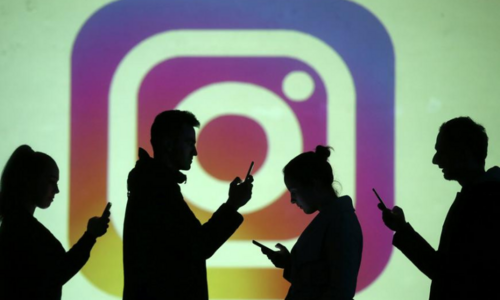
Meta Platforms Inc's image-sharing platform Instagram was down for thousands of users on Thursday, according to outage-tracking website Downdetector.com.
More than 6,000 users reported issues with Instagram on Downdetector, which tracks outages by collating status reports from several sources including user-submitted errors on its platform. The outage may be affecting a larger number of users.
According to the website, 84 per cent of reports flagged trouble with accessing the Instagram mobile application.
Meta Platforms said it was working on the issues. “We're aware that some people are having trouble accessing Instagram,” Meta said in a statement.
“We're working to get things back to normal as quickly as possible and we apologise for any inconvenience.”
Major social media services including Facebook, Instagram and WhatsApp were hit by a massive outage in October last year, impacting hundreds of millions of people.
In an apologetic blog post, the vice president of infrastructure at Meta, then known as Facebook, Santosh Janardhan, said that “configuration changes on the backbone routers that coordinate network traffic between our data centres caused issues that interrupted this communication”.
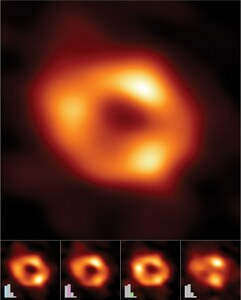
This image is taken by the Event Horizon Telescope (EHT) and shows the shadow of the black hole at the centre of our own galaxy, the Milky Way -Event Horizon Telescope Collaboration
Our galaxy is huge. Our Sun is just one star amongst more than 200 billion in the Milky Way. We like to think that we are special. But our Sun, along with the Earth, is located in the outskirts of our galaxy. We are so far away from the centre of the galaxy, that even travelling at the speed of light, it would still take 26,000 years to get to it.
But the centre of the galaxy is a busy place. There are a lot more stars in that region compared to our place in the galaxy. But there, right at the centre, is also a giant black hole.
Now the existence of black holes was first predicted as a consequence of Einstein’s General Theory of Relativity. The gravity of such objects is supposed to be so intense that not even light can escape from it — hence the name, ‘black hole’. This inference was so strange that Einstein himself doubted their actual existence.
But nature does not rely on scientific reputations. Later work showed that stars much larger than our Sun would indeed end up in the strange state of black holes. Our Sun will never become one. Instead, it will end its life as a white dwarf, a weird object but considerably less strange than a black hole. I don’t know if we should feel happy or sad about our Sun.
Astronomers have unveiled the first image of the supermassive black hole that resides at the centre of our own Milky Way galaxy. This result offers new insights on how giant black holes interact with their surroundings
As you can imagine, it is challenging to find black holes. But they cannot hide themselves completely. When material falls on to a black hole, it usually forms a disk. The material in the disk is sped to incredibly high speeds before it falls into the ‘event horizon’ — the place of no return. Nothing can escape the event horizon, but the disk around it can get very hot due to friction, and can betray its presence by emitting X-rays or other forms of light.
In our own galaxy, astronomers have occasionally detected stars orbiting invisible partners. Cygnus X-1, for example, is one such system, where the disk is so hot that it emits light in the form of high-energy X-rays. We do not see the black hole directly, but all indications suggest that it is one.
These black holes are the end-state of stars that are 20 to 50 times more massive than our Sun. However, astronomers have also discovered black holes that are millions or even billions of times more massive than our Sun. These are called supermassive black holes and they reside almost exclusively at the centre of all large galaxies. Their formation is still a mystery. One such supermassive black hole was depicted in the 2014 sci-fi movie Interstellar.
In 2019, however, astronomers took the image of the shadow of the event horizon of a supermassive black hole at the centre of M87, a galaxy located 55 million light years away. This was the first time humans had directly seen the area right around the event horizon.
Now the existence of black holes was first predicted as a consequence of Einstein’s General Theory of Relativity. The gravity of such objects is supposed to be so intense that not even light can escape from it — hence the name, ‘black hole’. This inference was so strange that Einstein himself doubted their actual existence.
It took an incredible effort. Astronomers combined eight telescopes on four continents to create that image. In effect, they turned the entire Earth into a telescope. This combination of telescopes is called the Event Horizon Telescope (EHT).
The Milky Way also has a supermassive black hole at its centre. We have known about its existence as we have seen its gravity speed up stars and gas clouds around it. In fact, the 2020 Nobel Prize was shared by Andrea Ghez and Reinhard Genzel for observations that showed the existence of this supermassive back hole. We call this black hole Sagittarius A*, shortened to Sgr A*, but pronounced Sagittarius A Star.
But what does it look like? Can we see the light right next to its event horizon?
You would think that imaging our very own supermassive black hole would be easier than the one located at the heart of M87, 55 million light years away. That is not the case. First, our own Sgr A* is much smaller in mass. It is only four million times the mass of our Sun. In comparison, the one in M87 is 1,500 times bigger, or more than six billion times the mass of our Sun.
In 2019, astronomers took the image of the shadow of the event horizon of a supermassive black hole at the centre of M87, a galaxy located 55 million light years away. This was the first time humans had directly seen the area right around the event horizon. It took an incredible effort.
This is important, as it results in material moving faster closer to the event horizon, making it difficult to combine images from the set of telescopes that make up EHT. Second, since we are located in the disk of the galaxy, we have to see through a lot of material between us and Sgr A*.
This past week, the EHT team finally released the first-ever image of the shadow of the supermassive black hole at the centre of the Milky Way. It looks like a doughnut. I should clarify that this is not visible light. Instead, astronomers are seeing this in radio waves.
The central part is dark because any light across that region falls into the black hole, creating a shadow or a silhouette of the event horizon. The size of this dark region is about 65 million km across, comparable to the orbit of planet Mercury in our solar system. Amazingly, the size of the doughnut fits perfectly well with the predictions of Einstein’s General Theory of Relativity.
This is a stunning confirmation of our physics and prior observations. Nature is under no obligation to follow our musings. And yet, here we are.
The next time you are feeling a bit down, perhaps after reading the world news, think about this: tiny beings on a small planet, orbiting an ordinary star in the far outskirts of the Milky Way, have confirmed the existence of a mysterious supermassive black hole at the centre of our galaxy.
The team of Earthlings behind the EHT should get news headlines across the galaxy.
The writer is Professor of Integrated Science & Humanities at Hampshire College in the US. He is also an astronomer affiliated with the Five College Astronomy Department (FCAD) in Massachusetts and hosts shows on the YouTube channel Kainaat Astronomy in Urdu
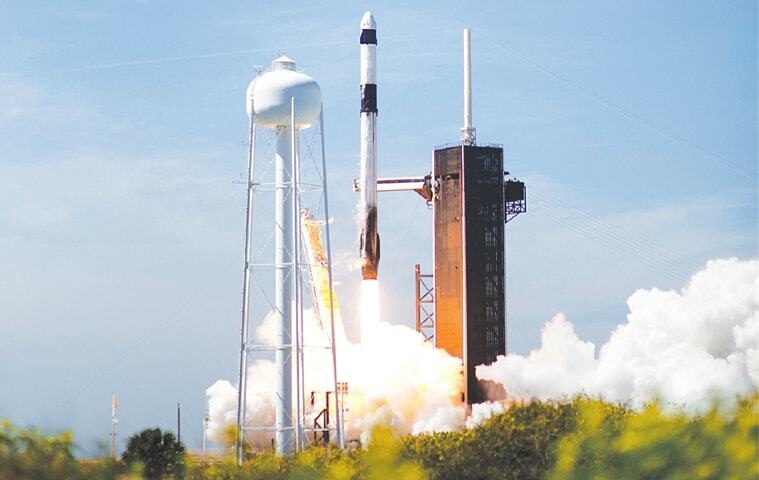
A rocket of SpaceX Falcon 9 carrying the company’s Crew Dragon spacecraft blasts off to the International Space Station at Nasa’s Kennedy Space Centre in Florida on Friday.—AFP/File The first fully private mission reached the International Space Station early on Saturday with a four-member crew from startup company Axiom Space.
The National Aeronautics and Space Administration (Nasa) has hailed the three-way partnership with Axiom and SpaceX as a key step towards commercialising the region of space known as “Low Earth Orbit,” leaving the agency to focus on more ambitious voyages deeper into the cosmos.
A SpaceX Falcon 9 rocket with the Crew Dragon capsule Endeavor docked at 1229 GMT on Saturday and the crew entered the space station nearly two hours later, after launching from the Kennedy Space Centre in Florida on Friday.
Commanding the Axiom Mission 1 (Ax-1) is former Nasa astronaut Michael Lopez-Alegria, a dual citizen of the US and Spain, who flew to space four times over his 20-year-career, and last visited the International Space Station (ISS) in 2007.
He is joined by three paying crewmates: American real estate investor Larry Connor, Canadian investor and philanthropist Mark Pathy and Israeli former fighter pilot, investor and philanthropist Eytan Stibbe.
“We're here to experience this but we understand there's a responsibility,” Connor said in comments shown on Nasa's live feed.
As the first civilian crew, he said, they “need to get it right.”
The widely reported price for tickets — which includes eight days on the outpost, before eventual splashdown in the Atlantic — is $55 million.
While wealthy private citizens have visited the ISS before, Ax-1 is the first mission featuring an all-private crew flying a private spacecraft to the outpost.
Houston-based Axiom pays SpaceX for transportation, and Nasa also charges Axiom for use of the ISS.
Research projects On board the ISS, which orbits 250 miles (400 kilometres) above sea level, the quartet will carry out 25 research projects, including an MIT technology demonstration of smart tiles that form a robotic swarm and self-assemble into space architecture.
Another experiment involves using cancer stem cells to grow mini tumors, and then leveraging the accelerated ageing environment of microgravity to identify biomarkers for early detection of cancers.
“Our guys aren't going up there and floating around for eight days taking pictures and looking out of the cupola,” Derek Hassmann, operations director of Axiom Space, told reporters at a pre-launch briefing.
In addition, crewmember Stibbe plans to pay tribute to his late friend Ilan Ramon, Israel's first astronaut, who died in the 2003 Space Shuttle Columbia disaster when the spaceship disintegrated upon reentry.
Surviving pages from Ramon's space diary, as well as mementos from his children, will be brought to the station by Stibbe.
The Axiom crew will live and work alongside the station's regular crew: currently three Americans and a German on the US side, and three Russians on the Russian side.
The company has partnered for a total of four missions with SpaceX, and Nasa has already approved in principle the second, Ax-2.
Axiom sees the voyages as the first steps of a grander goal: to build its own private space station. The first module is due to launch in 2024.
The plan is for the station to initially be attached to the ISS, before eventually flying autonomously when the latter retires and is deorbited sometime after 2030.


